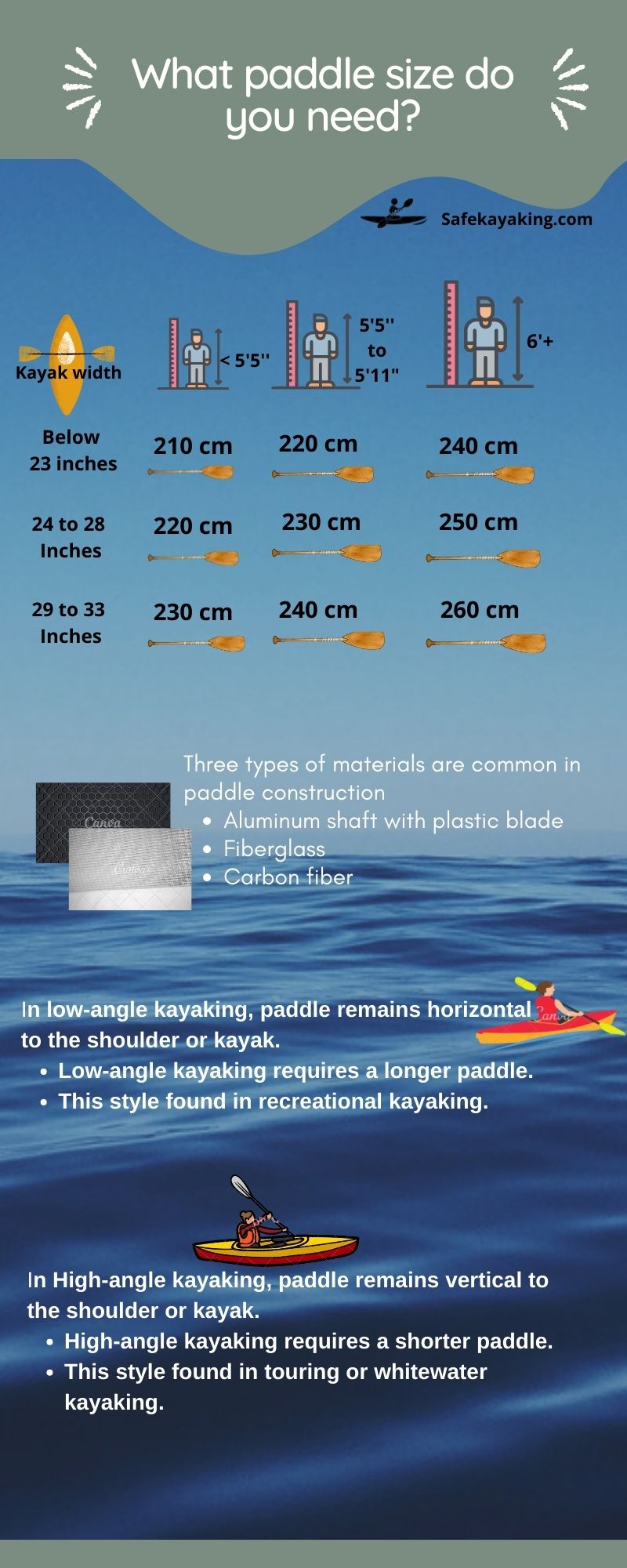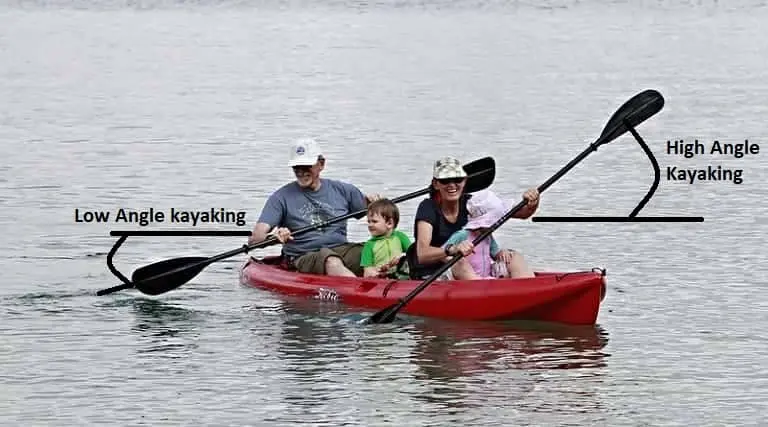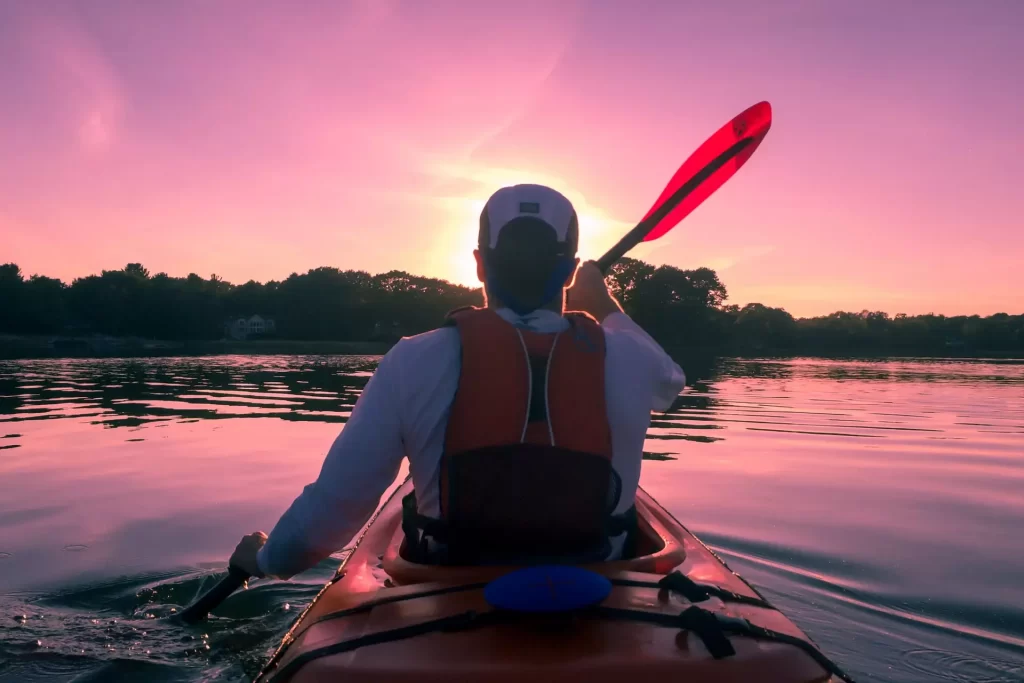All the paddles are not suitable for everyone though they are good paddles from the user’s point of view. There are certain factors that lie in a good paddle. If you want to stay longer on the water or something that will not hurt your muscles or joints, you should know about the right kayak paddle size.
In this article, I will guide you to choose the right kayak paddle size that will give you ultimate comfort and usability. I will also describe what type of specifications will be for what and how much it could cost a paddle for different type of materials.
Let’s learn some basic anatomy of a paddle. If you know these basics, it will help you to understand your choice and requirements.
Table of Contents
Kayak paddle Anatomy

Selection of a good paddle requires a good understanding of the anatomy of a paddle. A paddle generally consists of a shaft, drip ring, throat, spine, blade, power face, and non-power face.
Shaft
A shaft is a handle that allows you to hold the paddle and transmit your power to the blade. The shaft is made of different types of material. The aluminum shaft is most common nowadays. It is lighter and easy to use.
All carbon fiber paddles is also gaining its popularity due to its durability and high performance in rocky and creek area kayaking.
There are two types of shafts found in the market. One is the straight shaft and the other is the bent shaft. Bent shafts are ergonomically designed for its users for ultimate comfort. Most of the shafts are adjustable. You can change the length as your requirement.
Drip ring
The drip ring is near the throat of the paddle to prevent water from coming in during paddling. It is normally made of rubber or plastic.
Throat
The last portion from where the blade starts is known as the throat. it is basically rounded in shape between the shaft and blade joints. The rounding off the throat improves the strength of the paddle.
Spine
The length of the shaft that extends into the paddle blade is known as the spine.
Blade
The most important part of a paddle is the blade. It determines how powerful your stroke is and how much energy you require to use it. Generally, there are two types of blades available. One is wider blade and the other is slimmer blade.
A wider blade requires more energy to give a stroke than a slimmer blade. The blade has two faces-power faces and a non-power face. The concave surface is the power face and the opposite or convex surface is the non-power face. As the name says, the power face is used for propelling the kayak and the non-power face is used for easy withdrawal of the blade from the water.

Paddle Material Plays A Vital Role
Kayak paddles are made of different types of material like- Aluminum, plastic, fiberglass, and carbon fiber. The durability and comfort of a paddle largely depend on the materials of the paddle.
The lighter paddles are more comfortable than a heavier paddle. Flexible paddle blades are not as efficient as a rigid blade paddle because flexible blade absorbs a good amount of energy by bending in the water.
Paddle made of Aluminum or plastic materials tend to be heavier than carbon fiber paddle and not that much stronger. The glass fiber paddles are comparatively lighter and stronger than aluminum paddles. You can do almost any sort of kayaking with a fiberglass paddle.
The premium quality paddle is the carbon fiber paddle. These are lighter and stronger than any sort of materials and hence costlier than all.
So, if you are a beginner and paddle usually in flat water without any rapids or short-distance kayaking, you can choose an aluminum paddle. These are low-cost paddles and good for starting up and learning some paddling techniques.
After learning a few basics of kayaking, you can go with a fiberglass paddle because you now know about your requirement in paddle selection. If you planning to paddle in rocky rapids and want high performance durable paddle, you can choose a premium carbon fiber paddle.
If you ask me to choose for you, my recommendation will go for a fiberglass paddle. It will serve all of your purposes nicely under a moderate cost.
Kayak Paddle Size Depends On Paddling Angle

There are two types of angle paddlers used during kayaking. One is low-angle paddling and the other is the high angle paddling. Whenever you put your paddle far away from the kayak and keep the paddle shaft almost horizontal to your shoulder then you are paddling with a low angle.
If you put your paddle blade close to the kayak and hold the paddle shaft vertical to the kayak, then you are paddling at a high angle. The type of angle is essential for selecting a perfect size paddle.
If you want relaxed or recreational kayaking and don’t want much agility, low-angle paddling technique will be good for you. If you want straighter tracking with quick performance, high-angle paddling technique will be good for you. So, the question is-what should the paddle size be for both types?
Well, for low angle paddling, you should choose a longer and slimmer paddle. While for high angle paddling, you should choose a wider and shorter paddle.
Paddle Size Depends On Your Height And Width Of Kayak
There is a rational relation between your height and paddle size. If you are a tall person, you should choose a longer paddle than a shorter person for the same style of kayaking.
There is also a relation between your palm size and the paddle shaft. If your palm is not large, you should not choose a paddle that has a larger diameter of the paddle shaft.
A large diameter paddle shaft is uncomfortable for long time paddling. Another important factor to consider during kayak paddle size selection is the width of your kayak. Wider kayaks require a longer paddle.
Recreational and Touring kayak paddle size
Touring and recreational kayak require comparatively longer paddle than a white water kayak or performance kayak. In touring or recreational kayaking, we see two type of paddling- low angle and high angle paddling.
If you are comfortable with low-angle kayaking, you should choose a paddle with longer paddle. Otherwise choose a shorter one. We tabulated the following data for high-angle paddling. If you want a paddle for low angle paddling at which you feel comfortable, add 10 cm extra to this tabulated data for paddling size.
Recreational or touring kayak paddle size:
Your Height | kayak width < 23" | kayak width 24"- 28" | kayak width 29" - 33" | kayak width 34" + |
|---|---|---|---|---|
Below 5'5" | 210 cm | 220 cm | 230 cm | 240 cm |
5' 5" to 5'11" | 220 cm | 230 cm | 240 cm | 250 cm |
Above 6' | 225 cm | 235 cm | 250 cm | 260 cm |
White Water Kayak Paddle Size
According to our previous description we already knew that whitewater kayaking require shorter paddle than a recreational paddle.
Hard shell white water kayak size:
Kayaker Height | Recommended paddle length |
|---|---|
Below 5' 4" | 190 - 195 cm |
5'5" to 5'11" | 195 - 200 cm |
Over 6 | 200 - 203 cm |
inflatable whitewater kayak paddle size:
Kayaker Height | Recommended paddle length |
|---|---|
Below 5' 4" | 220 cm |
5'5" to 5'11" | 230 cm |
Over 6 | 240 cm |
Inflatable kayaks are wider than hard-shell kayaks. We know that width of kayak also important for selecting a perfect paddle. If you choose a shorter paddle for a wider kayak, your paddling efficiency will dramatically decrease.
Every time you give a stroke, there is a chance of hitting your boat as you are not reaching water comfortably. For white water kayaking width of kayak is not as critical as recreational kayak. Hence, we tabulated our recommended paddle length considering average width kayak and carefully separated these data for two different type of kayaks.


